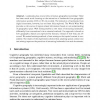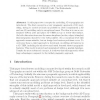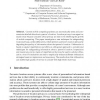COSIT
2005
Springer
14 years 8 months ago
2005
Springer
Landmarks play crucial roles in human geographic knowledge. There has been much work focusing on the extraction of landmarks from geographic information systems (GIS) or 3D city mo...
COSIT
2005
Springer
14 years 8 months ago
2005
Springer
The Foundational Model of Anatomy (FMA) is a map of the human body. Like maps of other sorts – including the map-like representations we find in familiar anatomical atlases – i...
COSIT
2005
Springer
14 years 8 months ago
2005
Springer
In previous empirical work humans did not recognize the definition of most topological operators for regions by their names in two geospatial information systems (GIS). This work d...
COSIT
2005
Springer
14 years 8 months ago
2005
Springer
In this paper two concepts for modelling 3D topography are introduced. The first concept is a very pragmatic approach of 3D modelling, trying to model as much as possible in (less...
COSIT
2005
Springer
14 years 8 months ago
2005
Springer
Arrows are major components of diagrams, where they are typically used to facilitate the communication of spatial and temporal knowledge. An automated interpretation of arrow diagr...
COSIT
2005
Springer
14 years 8 months ago
2005
Springer
Abstract. This paper complements landmark research with an approach to formalize the structural salience of objects along routes. The aim is to automatically integrate salient obje...
COSIT
2005
Springer
14 years 8 months ago
2005
Springer
How can the usability of distributed and heterogeneous geographic data sets be enhanced? Semantic interoperability is a prerequisite for effectively finding and accessing relevant ...
COSIT
2005
Springer
14 years 8 months ago
2005
Springer
Abstract. Current mobile computing systems can automatically sense and communicate detailed data about a person’s location. Location privacy is an urgent research issue because c...
COSIT
2005
Springer
14 years 8 months ago
2005
Springer
According to choice models in economics, consumer choice can be modeled as a two-stage process, starting with the choice of feasible alternatives, called the screening process, fol...



